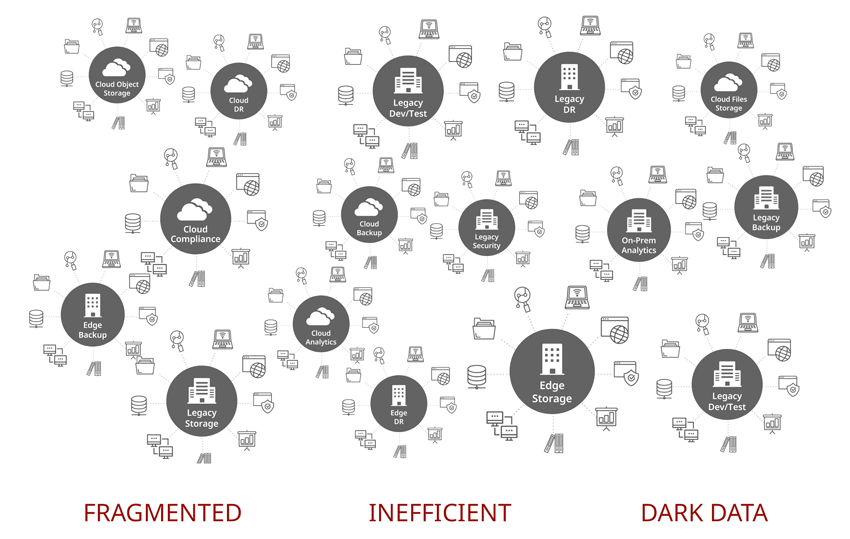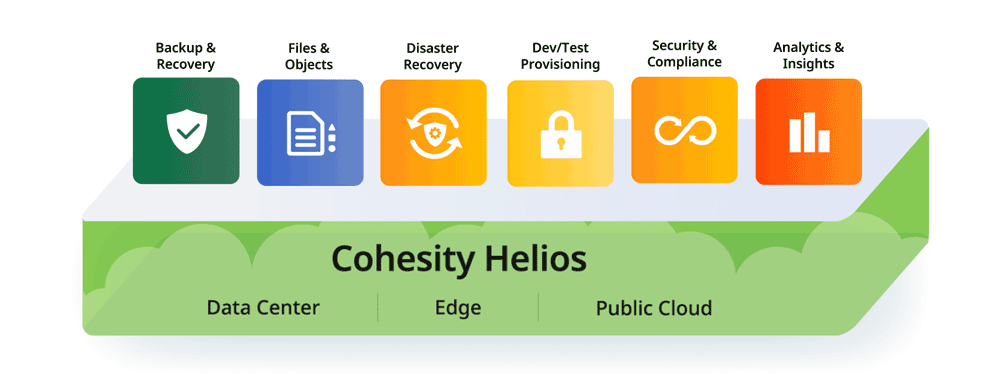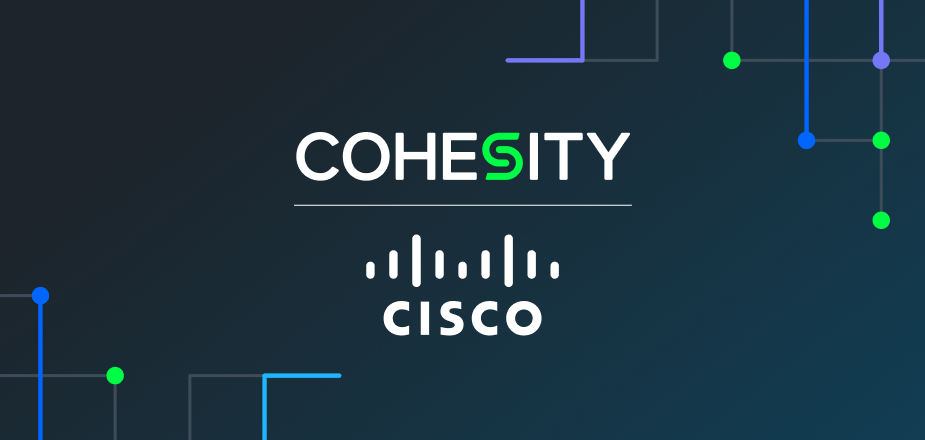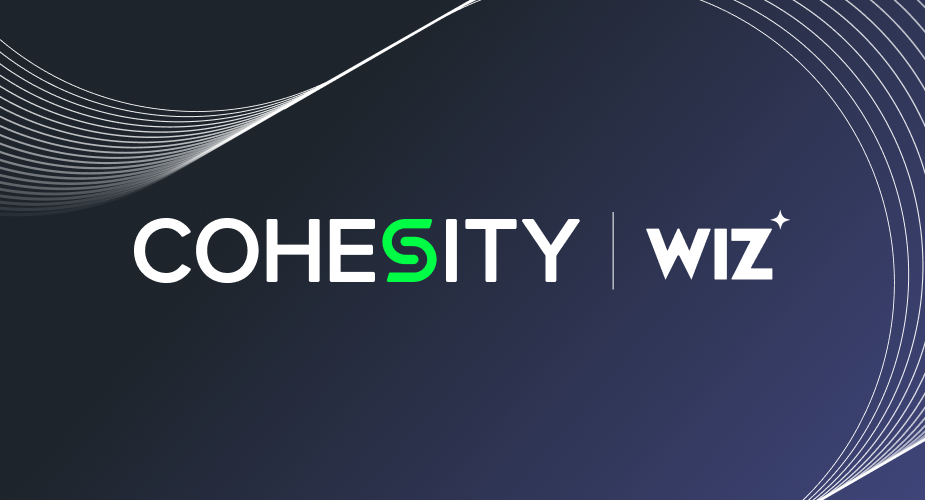In a blog published last year, we declared that legacy approaches to data management had become outdated, complex, inefficient and unsafe, and that a whole new approach is needed to support digital business in the multicloud era.
Nothing we have seen since has changed our minds:
- In 2020 there were reportedly 65,000 ransomware attacks in the US alone – that’s over 7 per hour
- IT teams are spending 40% of their time managing and maintaining data infrastructure
- Only 32% of data available to enterprises is put to work — the remaining 68% goes unleveraged
- Google, Amazon, Facebook and Twitter have all been the subject of GDPR breach investigations
That’s quite an indictment of the legacy generation of data management tools, which IT teams still grapple with to perform and manage routine functions including backup, file and object services, disaster recovery (DR), security, governance, dev/test, and analytics.
Cloud adoption has only increased the complexity: 90% of enterprises expect their cloud usage to exceed their plans prior to COVID-19, while 92% have a multicloud strategy.
More importantly, these tools are not just failing IT — they are also failing the business in terms of its online reputation, its operating efficiency, and its ability to use data as a strategic asset.
The Current State of Data Management
There has been almost no fundamental innovation from the legacy vendors in 25 years. From the outset their approach has been to produce specialist tools optimized for a single function, such as backup, file services or DR, that are deployed in silos that don’t interoperate.
And while a wave of newer entrants brought SaaS-based versions of these tools to market, they didn’t address the mass data fragmentation issue that added dozens more single-purpose ‘service silos’ to the mix.
In general, the current generation of data management tools can be characterized as:
- Complex: The ‘DIY’ task of managing multiple products from multiple vendors across an increasingly diverse landscape has become an unscalable time sink for already-stretched IT teams and a major contributor to higher TCO. Not only are operational SLAs jeopardized, but there is massive inefficiency from the proliferation of duplicated data and low optimization of expensive resources.
- Risky: Many current generation tools were designed decades ago, before the advent of today’s sophisticated cyberattack techniques, and their attack surface is multiplied by isolated components that don’t share a common security policy or visibility into incoming threats. A single ransomware attack can destroy a company’s reputation and operation in minutes.
- Unintelligent: The vast interconnected nature of today’s digital business was not envisaged by earlier generation tools, leaving IT teams to manually manage every aspect of the operation without assistance or forewarning of upcoming issues. Still less are they able to provide intelligence to the business by analyzing the data for insights.
- Closed: Many traditional solutions were designed for a single siloed function, such as backup or file services, without a rich set of APIs, making them difficult to extend or integrate with modern orchestration and automation tools. Additionally, they don’t support the ability to run external applications – such as analytics, reporting or compliance – directly against the global data, further limiting their business value.
This pattern looks set to continue, as legacy vendors make only incremental improvements within their own silos and don’t step back to reconsider the overall problem for global benefit. This insular and archaic thinking has serious consequences as we have seen, but it also opens up an enormous opportunity to change things for the better.

Next-Gen Data Management
We believe a true solution can only be achieved with a fundamental redesign of the underlying architecture. Instead of an arcane collection of siloed components, next-gen data management should be a pervasive, invisible service, available wherever the data is located across the multicloud and to whoever is accessing it, helping to ensure the data is available, protected, visible, compliant, movable, and accessible to third-party apps. Next-gen data management should also play a key role in helping businesses improve their security postures — and all of this should take place with minimal management overhead for IT.
In the previous blog we outlined how our founder and CEO, Mohit Aron, adapted the architectural principles used by the largest hyperscalers to the unique demands of managing enterprise data. These breakthrough ideas, incorporated into the Cohesity Helios Multicloud Data Platform, tackle the central problem of fragmentation that has plagued the industry for so long, put IT back in control, and finally free the business to extract the value they need.
Next-gen data management directly addresses the limitations listed earlier:
Simplicity at scale
- Consolidate the silos: previously siloed functions are consolidated onto a single scalable software environment that runs multiple use cases at scale, slashing complexity and cost.
- Manage globally: the entire data management lifecycle can be managed from a single, intuitive user interface that provides global visibility and control of all distributed data and activity across the hybrid cloud, minimizing admin effort.
- Choose your deployment model: the platform runs natively in data centers as well as in public cloud and edge environments, and it can be managed in-house, by a partner, or subscribed to as a Cohesity-managed SaaS service. In all cases, the user enjoys the same productive and intuitive experience.
- No disruption: expansion and software upgrades take mere minutes and happen in-place transparently while operating normally, with no downtime.
- Enable developer self-service: developers no longer need to wait for IT to manually provision datasets for them to test their apps against. They can safely access zero-cost clones of production data instantly as needed on a self-service basis.
Zero Trust Security
- Enable global visibility and control: built for the hybrid cloud era, security has always been core to the Cohesity architecture. It starts with the hyperscale file system that spans from core to edge to clouds, enabling consistent control and visibility over all data no matter where it resides.
- Rely on proven, multi-level security: Cohesity is built on the notion of least privilege and segregation of duties – both for managing the data and administering the platform. Further deep, granular features add additional security onto our hardened platform, including multifactor authentication (MFA), role-based access control (RBAC), secure protocols such as (NBD-SSL and gRPC) write once read many (WORM), no service backdoor, and much more. Four of the top 10 financial institutions in the US depend on Cohesity to help keep their data secure.
- Take a holistic approach to ransomware: more than relying simply on backup and restore, digital businesses need an all-round approach, from pre-empting attacks with vulnerability scanning and anomaly detection, to rapid response with instant mass restore, automated DR/failover and true immutable data vaults via air gapping. This approach has been proven effective against real world ransomware attacks, resulting in $0 payment and minimal data loss.
- Leverage leading security ecosystem integrations: our hardened security can be further extended and operationalized through integrations with leading third-party apps and services from ServiceNow, Tenable and others, that provide vulnerability scanning and continuous monitoring and assessment of administrative activity and security posture of the platform.
Powered by AI
- Work smarter, not harder: a third critical aspect of next-gen data management is the ability to leverage AI and ML techniques to lighten the load and preempt problems. Myriad built-in capabilities, from rules-based automation of routine tasks to AI-based recommendations can give you your nights and weekends back.
- Automate threat visibility: to prevent threats at a much greater scale than humans can, powerful AI-based algorithms can monitor and detect anomalies in your environment in near real time, alerting you to potential danger and initiating counter measures such as recommending a clean backup for rapid recovery from a ransomware attack.
- Use a smart assistant: today’s distributed, complex IT environments make it increasingly difficult to monitor, plan and optimize operations. AI-enhanced algorithms constantly learn and adjust, averting potential issues and providing predictive analytics-based alerts such as capacity utilization trends and proactive wellness checks.
- Add AI-powered Marketplace apps: as an API-first platform, Cohesity can also enable powerful extensions that add value to your data. AI-powered apps from Cohesity as well as third parties can run in the same Cohesity environment as your data, improving accuracy and accelerating time to results.
Third Party Extensibility
- Bring apps directly to your data: instead of moving data to a separate system to extract insights, our platform is able to run apps and services directly against the managed data in the same Helios environment, whether on-premises or in a public cloud, considerably streamlining the traditional ETL process and accelerating results.
- Choose from the Marketplace: customers can easily discover and download apps from a SaaS-based Marketplace using the same intuitive UI as all other operations. They can choose from a wide range of third party and Cohesity apps for analytics, reporting, compliance, security, bare metal recovery, data masking, and more.
- Empower developers: the platform was designed from the outset as an API-first environment, and developers can use the same rich set of RESTful APIs and SDK that Cohesity engineers use to easily integrate next-gen functions into their apps and create new capabilities.
- Integrate with leading applications: take advantage of pre-existing integrations with familiar apps and tools in your current environment, including:
- Enable self-service operations through ready-to-use automation and orchestration tool integrations such as ServiceNow
- Automate infrastructure configuration management and deployment via deep integration with industry standard Infrastructure as Code solutions including Terraform and Ansible
- Build, automate and manage operational workflows to cut cost and time whether through leading solutions such as vRealize and vCloud Director, or custom viaPowershell Python

It’s Time for Next-Gen
We believe the legacy data management industry has failed to deliver the solution needed by today’s digital businesses, and that IT is in an increasingly untenable position given relentless data growth, flat to lower budgets, and pressure to deliver more business value.
Incremental improvements won’t cut it. Instead, IT needs a modern approach: a simpler, more secure and smarter way to take back control of their data across a dynamic multicloud landscape with minimal IT effort, that can also help unlock latent value for competitive advantage.
The good news is that such a solution is widely available today, and is already being used by thousands of organizations worldwide to save money, reduce risk and be more competitive. We invite you to explore what next-gen data management can do for your business.














